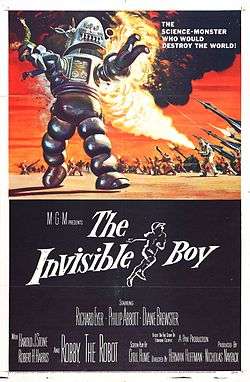The Invisible Boy
The Invisible Boy (aka S.O.S Spaceship) is a 1957 black and white American science fiction film from Metro-Goldwyn Mayer, produced by Nicholas Nayfack, directed by Herman Hoffman, and starring Richard Eyer and Philip Abbott. It is the second film appearance of Robby the Robot, the science fiction character who "stole the show" in Forbidden Planet (1956),[2] also released by Metro-Goldwyn-Mayer. According to an implied, subtle back story in The Invisible Boy, the robot is the same character as that in Forbidden Planet, which is set in the 23rd century; Robby is brought back to the film's mid-20th century era by time travel.
| The Invisible Boy | |
|---|---|
 | |
| Directed by | Herman Hoffman |
| Produced by | Nicholas Nayfack |
| Written by | Edmund Cooper (story) Cyril Hume |
| Starring | Richard Eyer Philip Abbott Diane Brewster Harold J. Stone |
| Music by | Les Baxter |
| Cinematography | Harold E. Wellman |
| Edited by | John Faure |
| Distributed by | Metro-Goldwyn Mayer |
Release date |
|
Running time | 90 minutes |
| Country | United States |
| Language | English |
| Budget | $384,000[1] |
| Box office | $840,000[1] |
Plot
The Invisible Boy is a mixture of lighthearted playfulness and menacing evil. In 1957, ten-year-old Timmie Merrinoe (Richard Eyer) seems only to want a playmate. After he is mysteriously invested with superior intelligence, he reassembles a robot that his father and other scientists had been ready to discard as irreparable junk. No one pays much attention to the robot, named Robby, after Timmie gets it operating again, until Timmie's mother becomes angry when her son is taken aloft by a huge powered kite that Robby has built at Timmie's urging.
When Timmie expresses a wish to be able to play without being observed by his parents, Robby, with the aid of a supercomputer, makes him invisible. At first Timmie uses his invisibility to play simple pranks on his parents and others, but the mood soon changes, when it becomes clear that the supercomputer is evil and intends to take over the world using a military satellite. The Supercomputer takes Timmie captive aboard the rocket, the army tries to stop Robby, but all of their artillery and weapons have no effect on him. Robby boards the ship, but frees Timmie rather than listening to the supercomputer. Dr. Merrinoe tells Timmie and Robby to remain onboard the ship as it enough supplies for him to last a year, but instead goes to earth.
Timmie and Dr. Merrinoe return to the lab to shut down the supercomputer, but it stops them. Robby then shows up, but turns against the supercomputer and destroys its power source. Everything is back to normal we find the Merrinoes having a peaceful evening, Dr. Merrinoe is about to whip Timmie as punishment for ignoring him. He is however stopped by Robby, and the film ends with a shot of the Merrinoes and Robby all having a peaceful evening together.
Cast
- Richard Eyer as Timmie Merrinoe
- Philip Abbott as Dr. Tom Merrinoe
- Diane Brewster as Mary Merrinoe
- Harold J. Stone as Gen. Swayne
- Robert H. Harris as Prof. Frank Allerton
- Dennis McCarthy as Col. Macklin
- Alexander Lockwood as Arthur Kelvaney
- John O'Malley as Prof. Baine
- Robby the Robot as Robby
- Gage Clarke as Dr. Bannerman (uncredited)
- Than Wyenn as Prof. Zeller
- Jefferson Searles as Prof. Foster (as Jefferson Dudley Searles)
- Alfred Linder as Martin / Computer
- Ralph Votrian as 1st Gate Sergeant
- Michael Miller as 2nd Gate Sergeant
Reception
According to MGM records, the film earned $390,000 in the US and Canada and $450,000 elsewhere, for a total of $840,000. With a budget of $384,000 this resulted in a profit of $456,000.[1]
Home media
The entire feature film appears as an extra on the Forbidden Planet 50th Anniversary DVD released in 2006 and on the Blu-ray released in 2010. Even on the Blu-ray, the film is in standard definition.
References
- The Eddie Mannix Ledger, Los Angeles: Margaret Herrick Library, Center for Motion Picture Study.
- Chaw, Walter (December 19, 2007). "Forbidden Planet - 50th Anniversary Special Two-Disk Edition". Archived from the original on 2010-06-20. Primarily a review of Forbidden Planet, Chaw has little use for The Invisible Boy.
Further reading
- Eder, Bruce (n.d.). "The Invisible Boy (1957)". allmovie by Rovi.
But in its own low-budget way, it is a fascinating pop-culture artifact of its time. And it is a lot of fun, just as a notion for a science fiction/adventure film, with a very dark side to the serious component of the plot.
- Schwartz, Dennis (May 9, 2004). "The Invisible Boy". Ozus' World.
Adults as well as children should be entertained by this sci-fier that succeeds without much technological gadgetry, instead relying on its charm.